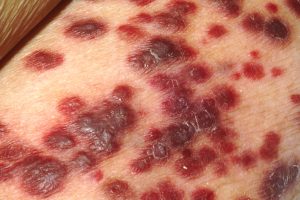Summary
Sarcoma is a type of cancer that can affect various parts of the body, specifically targeting soft tissues and bones. While early detection improves the chances of successful treatment, advanced cases of sarcoma can be life-threatening. Sarcoma is one of the less common types of cancer, with various forms depending on the affected tissue.
This type of cancer is rare among adults and is more commonly seen in children and young adults. Most cases of sarcoma begin in the arms or legs, although it can also appear in the abdomen or chest. Rarely, sarcoma develops in the neck or head.
The exact cause of sarcoma is still unknown. However, certain risk factors are associated with a higher likelihood of developing sarcoma. These include genetic factors, smoking, exposure to certain chemicals, and heavy alcohol consumption.
Common symptoms of sarcoma include a lump or swelling in the affected area, pain, abdominal discomfort, weakness, and unexplained weight loss. Treatment options typically include surgery, radiation therapy, and chemotherapy.
Table of Contents
Symptoms of Sarcoma

Sarcoma is a type of cancer that can affect various parts of the body, leading to a range of symptoms depending on the area involved. Here are the common symptoms associated with sarcoma:
- Presence of a Lump. A palpable lump beneath the skin that may or may not be painful.
- Bone Pain. Persistent pain in the bones, especially in the arms, legs, or pelvis.
- Unexplained Bone Fractures. Sudden fractures in the bones without any noticeable injury or trauma.
- Abdominal Pain. Discomfort or pain in the abdominal area, particularly in cases where sarcoma affects the organs or tissues in the abdomen.
- Unexplained Weight Loss. A sudden, unexplained loss of weight that occurs without dietary or lifestyle changes.
These symptoms are similar to those of other conditions, so it’s essential to consult a healthcare professional if any of these signs are noticed. Early detection and diagnosis can greatly improve treatment outcomes.
What are the risk factors that increase the likelihood of developing sarcoma?
Types of Sarcomas
Sarcoma is classified into two main types: soft tissue sarcoma and bone sarcoma. Each type affects different parts of the body, with various subtypes under each category.
Soft Tissue Sarcoma
This type of sarcoma affects the body’s soft tissues. It has several subtypes, including:
- Angiosarcoma. This type affects blood vessels or lymphatic vessels.
- Gastrointestinal Stromal Tumor (GIST). Affects neuromuscular cells in the stomach and digestive tract.
- Kaposi’s Sarcoma. Originates from human herpesvirus 8 and primarily affects the skin but can also spread to other body parts.
- Liposarcoma. Develops in fatty tissues, often found in the thighs, behind the knees, or the back of the abdomen.
- Leiomyosarcoma. Found in smooth muscles that line organs within the abdomen.
- Synovial Sarcoma. A tumor that arises from stem cells, often found near joints.
- Neurofibrosarcoma. Starts in the protective coverings of nerves.
- Rhabdomyosarcoma. Develops in skeletal muscle tissue.
- Fibrosarcoma. Affects connective tissue cells, primarily targeting the fibrous tissue in the body.
- Myxofibrosarcoma. Affects connective tissues, often in the arms or thighs of older adults.
- Mesenchymoma. A rare form of sarcoma that can develop in any part of the body.
- Vascular Sarcoma. Affects blood vessels and is known to spread through the vascular system.
- Schwannoma. Develops in the protective coverings around nerves.
Bone Sarcoma
Bone sarcomas are those that affect bone tissues. The primary types include:
- Chondrosarcoma. Starts in the cartilage and can spread to nearby bones.
- Ewing Sarcoma. Can affect both soft tissues and bones, often seen in children and young adults.
- Fibrosarcoma of the Bone. Affects fibrogenic tissues, which are a type of connective tissue found in bones.
- Osteosarcoma. The most common type of bone sarcoma, typically affecting the long bones in the arms and legs.
Why Does Sarcoma Occur?
The exact causes of sarcoma remain unclear, but several factors may increase the risk of developing this type of cancer. These include genetic predispositions, exposure to certain chemicals, smoking, and heavy alcohol consumption. Additionally, some sarcomas are linked to inherited conditions and family history, while others may develop after exposure to radiation or due to chronic inflammation in specific body tissues.
Diagnostic Procedures for Sarcoma
Diagnosing sarcoma involves a combination of physical examinations, imaging tests, and tissue sampling to confirm the presence of cancer. Here are the key diagnostic procedures used:
- Physical Examination. The initial step often involves a physical exam where the doctor checks for lumps, swelling, or other abnormalities in the affected area. They will ask about any pain, recent injuries, or family history of cancer.
- Imaging Tests. Imaging plays a crucial role in locating the tumor and assessing its size, spread, and nature. Common imaging tests include:
- X-rays. Used primarily for bone sarcomas, X-rays can reveal irregularities or damage in the bones.
- MRI (Magnetic Resonance Imaging). This is often used to get a detailed view of soft tissue sarcomas, showing the tumor’s size, shape, and exact location.
- CT Scan (Computed Tomography). CT scans provide cross-sectional images of the body and are helpful for viewing both bone and soft tissue sarcomas, especially to check for any spread to the lungs or other areas.
- PET Scan (Positron Emission Tomography). A PET scan detects metabolic activity, allowing doctors to identify areas of high cell activity, which may indicate cancer spread.
- Biopsy. The most definitive diagnostic procedure for sarcoma is a biopsy, where a sample of the suspicious tissue is removed and examined under a microscope. There are different types of biopsies:
- Needle Biopsy. A needle is inserted into the tumor to withdraw a small tissue sample. This is a minimally invasive procedure often used initially.
- Core Biopsy. A larger needle is used to extract a more substantial sample from the tumor, providing more information about the cells.
- Surgical Biopsy. In cases where needle biopsies are inconclusive, a minor surgical procedure may be performed to remove part or all of the tumor for analysis.
- Molecular and Genetic Testing. Sometimes, additional testing is done on the biopsy sample to determine specific genetic mutations or molecular markers. This information can help doctors understand the sarcoma’s characteristics and guide personalized treatment options.
- Blood Tests. Although blood tests do not directly diagnose sarcoma, they can help assess the patient’s overall health, check for markers of inflammation, or identify abnormalities that could suggest metastasis or the effects of the tumor on other organs.
These diagnostic procedures allow healthcare providers to assess the type, stage, and spread of sarcoma, which is essential for developing an effective treatment plan.
Complications of Untreated Sarcoma

If sarcoma is left untreated, it can lead to severe complications that impact the body and quality of life. Here are some of the primary complications associated with untreated sarcoma:
- Local Invasion and Tissue Damage. Sarcoma tumors can grow larger over time, invading nearby muscles, blood vessels, nerves, and other tissues. This can cause increased pain, swelling, and decreased mobility in the affected area. In severe cases, untreated sarcoma may lead to tissue necrosis (death) and loss of function in the affected body part.
- Fractures (Bone Sarcoma). In cases where sarcoma affects the bones, such as osteosarcoma or chondrosarcoma, the cancer can weaken the bone structure, leading to fractures. These fractures may occur even with minimal or no trauma and can be painful and difficult to treat.
- Metastasis (Spread to Other Organs). Sarcoma has a high risk of spreading (metastasizing) to other parts of the body, particularly the lungs, liver, and sometimes the brain. Metastatic sarcoma is much harder to treat and typically has a poorer prognosis, as it can significantly impair the function of critical organs.
- Compromised Organ Function. Depending on where the sarcoma develops, untreated growths can impair the functioning of nearby organs. For instance, sarcoma in the abdomen may interfere with digestion or organ function, while sarcoma in the chest may affect breathing.
- Severe Pain and Discomfort. As sarcoma progresses, the associated pain and discomfort typically worsen. This can interfere with daily activities and cause significant physical and emotional stress, severely impacting the patient’s quality of life.
- Weight Loss and Fatigue. Progressive sarcoma often leads to unexplained weight loss and chronic fatigue as the body uses more energy to support the growth of cancer cells. This can lead to muscle wasting, malnutrition, and general weakness.
- Infection and Immune System Compromise. Advanced sarcoma, particularly when it invades bones and soft tissues, can increase the risk of infection. In cases where the immune system is compromised, infections become more frequent and harder to control, posing additional risks to the patient’s health.
- Death. Ultimately, untreated sarcoma can be life-threatening, especially if it spreads to vital organs. The complications from metastasis, organ failure, or severe infections can lead to death.
Early detection and treatment of sarcoma are essential to avoid these serious complications. Timely intervention can improve survival rates and help maintain a better quality of life.
Causes of Sarcoma
Like other types of cancer, the exact cause of sarcoma remains unclear, and medical experts continue to research the underlying factors that contribute to the development of this disease.
Studies have shown that sarcoma can often appear unexpectedly, with no clear familial link or hereditary pattern. However, certain risk factors are known to increase the likelihood of developing sarcoma, even though the condition itself is not typically inherited. These factors will be discussed in more detail in the subsequent sections of this article.
Prevention of Sarcoma

While sarcoma, like other types of cancer, cannot be entirely prevented, certain habits can help lower the risk. Here are some practices that may aid in reducing the likelihood of developing sarcoma:
- Avoid Smoking and Tobacco Products. Cigarettes and other tobacco products contain chemicals that increase the risk of various types of cancer, including sarcoma. Quitting smoking or avoiding tobacco entirely is one of the best preventive measures.
- Engage in Regular Exercise. Modern studies have shown that regular physical activity can help reduce the risk of many cancers. Experts recommend at least 30 minutes of exercise daily to maintain overall health and strengthen the immune system.
- Limit Alcohol Consumption. Excessive alcohol intake is also a risk factor for various cancers. If it’s not possible to avoid alcohol completely, try to consume it in moderation to reduce cancer risk.
- Monitor Your Health. Regular health check-ups are essential for early detection of cancer. This is especially important if there is a family history of cancer. Early screening can help identify any potential issues before they progress.
By adopting these habits, you can support your health and potentially reduce the risks associated with sarcoma and other cancers.
Risk Factors for Sarcoma
As previously mentioned, the exact cause of sarcoma is still uncertain. However, certain factors have been identified that increase the risk of developing this type of cancer:
- Inherited Conditions. Certain genetic disorders can increase the risk of sarcoma. Examples include familial retinoblastoma, a type of eye cancer, and neurofibromatosis type 1, a condition that causes tumors to form on nerve tissue.
- Previous Radiation Therapy. Exposure to radiation, even when used to treat other types of cancer, can increase the likelihood of developing sarcoma later in life.
- Chronic Swelling (Lymphedema). Lymphedema occurs when lymph fluid builds up due to blockage in the lymph nodes, which increases the risk of developing angiosarcoma, a type of sarcoma that affects blood vessels.
- Chemical Exposure. Exposure to certain chemicals and substances, such as vinyl chloride and certain herbicides, can increase the risk of developing sarcoma, particularly in the liver.
- Exposure to Viruses. Certain viruses, such as human herpesvirus 8, are associated with an increased risk of developing Kaposi’s sarcoma, especially in individuals with weakened immune systems.
Being aware of these risk factors can help in early detection and in taking preventive measures, especially for individuals with a family history or those with previous cancer treatments involving radiation.
Sarcoma FAQs
- What is sarcoma?
Sarcoma is a rare type of cancer that develops in the body’s connective tissues, which include bones, muscles, fat, blood vessels, and lymphatic vessels. It can occur almost anywhere in the body but most commonly affects the arms, legs, abdomen, and chest. - What causes sarcoma?
The exact cause of sarcoma remains unknown. However, certain factors, such as genetic predisposition, exposure to radiation, and certain chemicals, can increase the risk. Some sarcomas are also linked to previous cancer treatments or genetic conditions. - What are the symptoms of sarcoma?
Common symptoms of sarcoma include a lump under the skin, which may or may not be painful, bone pain, unexplained fractures, abdominal pain, and unintentional weight loss. Symptoms vary depending on the affected area. - How is sarcoma diagnosed?
Sarcoma is diagnosed through a combination of physical exams, imaging tests (such as X-rays, MRI, or CT scans), and biopsy. A biopsy involves taking a sample of the affected tissue to examine it for cancer cells. - What are the types of sarcoma?
There are two main types: soft tissue sarcoma and bone sarcoma. Soft tissue sarcomas include subtypes like angiosarcoma, liposarcoma, and Kaposi’s sarcoma, while bone sarcomas include osteosarcoma, chondrosarcoma, and Ewing sarcoma. - Who is most at risk for developing sarcoma?
Sarcoma is more commonly found in children and young adults. People with certain inherited conditions, those who have undergone radiation therapy, and individuals exposed to certain chemicals or viruses also have an increased risk. - Can sarcoma be prevented?
There is no sure way to prevent sarcoma. However, reducing risk factors such as avoiding smoking, limiting alcohol intake, maintaining a healthy weight, and monitoring health through regular check-ups can help. - How is sarcoma treated?
Treatment options for sarcoma include surgery to remove the tumor, radiation therapy, and chemotherapy. The treatment approach depends on the type, location, and stage of the sarcoma. - Is sarcoma curable?
The prognosis for sarcoma depends on its type, location, and how early it is detected. Early-stage sarcomas have a better chance of successful treatment, while advanced cases are more challenging to treat. - What is the difference between sarcoma and carcinoma?
Sarcoma originates in the connective tissues (bones, muscles, fat, etc.), whereas carcinoma originates in the epithelial cells, which line organs and tissues. Carcinomas are more common than sarcomas and include cancers such as breast, lung, and prostate cancer.


